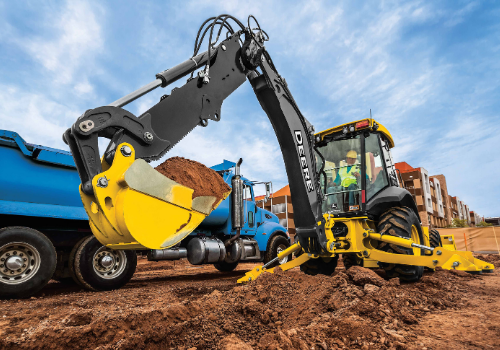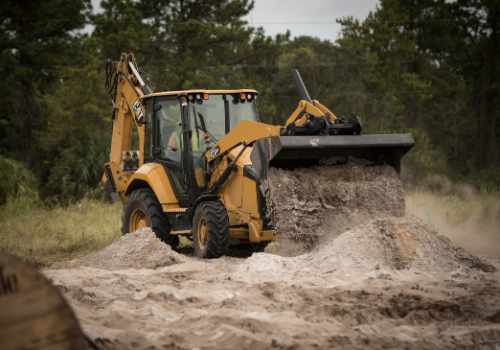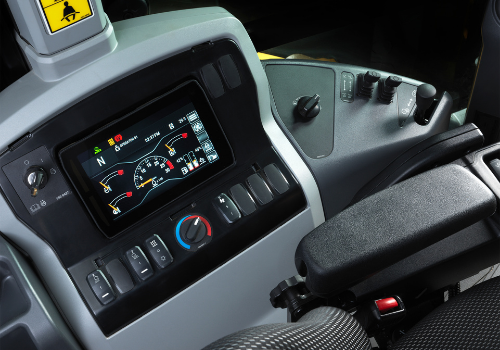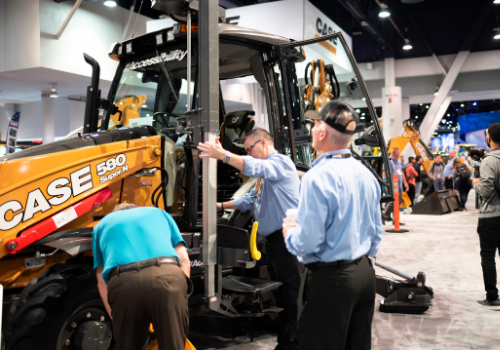 Know how to get the most from your backhoe loader while keeping operators productive and comfortable
Know how to get the most from your backhoe loader while keeping operators productive and comfortable
Adjustability and flexibility have become key to improving backhoe loaders and to keeping operators efficient, comfortable – and happy.
For Caterpillar, this means taking an approach to develop more comfort, more performance and more versatility with technological advancements such as new electro-hydraulic (EH), seat-mounted controls.
“We’re really focusing on keeping operators comfortable throughout the workday and keeping them as efficient as possible,” says Dustin Adams, Caterpillar product applications specialist for backhoe loaders. “We want to provide a lot of adjustability.”
Joysticks that have the ability to slide forward and aft to the desired operating position – along with an armrest that adjusts vertically to enable positioning for an operator’s shoulders to be straight and allow for other physical adjustments – are some of the important new advancements for operator comfort.
Flexibility with operator control modes such as adjustable Joystick Response and Hydraulic Modulation increases operator efficiency and comfort, both physically and in terms of running the machine.
“If an operator isn’t sure of himself or herself and wants finite control to be very deliberate with his or her actions, the joystick response and hydraulics can be adjusted to meet the skill set and technique,” Adams explains. “However, if there is an operator who has been in the seat for 20 years or wants a ‘quick and snappy’ reaction, the joystick response can be changed to fast and have a coarse modulation to react quickly to commands given – whether it is a skill set or an operating preference.
 Compact machines handling big jobs
Compact machines handling big jobs
Kubota’s B26 has an operating weight of 4,001 pounds; a backhoe dig depth of 8 feet, 4 inches; and a front loader lifting capacity of 1,102 pounds.
“Although it is compact in size, it’s ready to take on the next big job,” points out Patrick Baker, construction equipment product manager for Kubota Tractor Corp. “It’s innovative.”
Kubota’s L47 sports a HST (hydrostatic) Plus transmission, with 2,848 pounds of front loader lifting capacity and a 47.1-hp engine. Baker says it’s “ideal” for rental customers, landscapers and homeowners looking for a compact machine that is able to provide professional results.
The M62 has a 63-hp engine, performance-matched loader and backhoe, and a HST Plus transmission for applications including applications from landscaping jobs to commercial construction sites.
“Kubota continues to innovate and develop new TLB features to make the operator’s job easier and more productive,” Baker points out. “When it comes to utility installations, the backhoe crawling mode on the L47 and M62 save the operator time when repositioning during backhoe operation.”
Backhoe crawling mode allows the operator to creep forward or backward and reposition the machine while remaining at the backhoe controls, Baker explains. He also notes that the manufacturer’s TLBs have become a “fixture” during disaster relief and cleanup, Baker says.
The hydraulic two-lever quick coupler – available on the L47 and M62 – enables the equipment operator to quickly attach and detach front loader implements such as buckets, pallet forks, grapples and brooms. A throttle up switch also allows the power and speed of the attachment to increase, Baker notes, while the machine speed remains consistent.
“A quick coupler compatible with the L47 and M62 models – as well as some Kubota compact excavator buckets – allow for quick and easy bucket and attachment changes,” Baker adds.
Dealing with disaster relief
When dealing with disaster cleanup, equipment versatility is a key part of it, explains Caterpillar’s Adams. With this in mind, Caterpillar introduced a loader coupler for all of its models.
“It must be able to do many different things,” he says. “It can’t be a one-trick pony. When I think of disaster clean-up, I think about a multipurpose or four-in-one bucket – a bucket, a grapple, a box blade and a dozer blade all in one. It really serves a big purpose because you can scoop up material, gather large pieces of debris, clear roads, etc.”
In the past, customers would have to order or purchase the IT model, which had a different style loader arm – if they wanted a loader coupler. However, Cat developed an IT loader coupler for single-tilt loader arms.
“We now have IT couplers for all models 415 to 420, which really increases versatility and machine utilization,” Adams says. “Operators easily can drop buckets to attach a fork and then can drop and put on a broom to sweep streets or push snow. It gives the backhoe loader a lot of versatility.”
Now, attachments can be switched easily and quickly, turning a two-person operation into a one-person job.
“If the machine is equipped with a Hoe Coupler, it takes a matter of seconds to switch attachments if they are hydraulic and only matter of minutes if they are mechanical,” Adams explains. “Attachment portfolios really have evolved.”
Brian Hennings, product marketing manager for backhoes and tractor loaders at John Deere Construction and Forestry, reiterates not only have attachments evolved for backhoes but they are “very, very important.”
“They provide a multitude of increased options and versatility on the job site,” Hennings says. “You really have a tractor with an excavator in the rear and a front loader in the front. It’s a very versatile tool to have on a jobsite.
 Attachments creating versatility
Attachments creating versatility
As attachments have progressed, hydraulic thumbs, multipurpose (MP) buckets and grapples have become significant to backhoe loader versatility – especially for disaster relief efforts but also for utility work, Hennings says.
“Hydraulic thumbs can be advantageous for loading trucks and lifting larger limbs and branches,” he says. “They make it easier to grab whatever the operator is trying to lift, especially larger objects.”
MP buckets, developed in “pockets” of the United States, tend to make a machine much more useful by enabling it to get more done and quicker, Hennings points out. A new clamshell design on Deere backhoe loaders features tilt-free dumping, a reinforced third cutting edge, as well as improved hinge profile to minimize material spillage, according to Deere.
MP buckets on backhoe loaders can be very efficient and useful in underground utility repair – underground connection – applications. Operators can get in the trench with an MP bucket and open up the clamshell for filling the aggregate base to put over the top of it before it is backfilled, he says.
“Instead of having two machines or a lot of manual work with a shovel, you can push it around over the clay, dirt or spoil pile you dug out of it,” Hennings says. “An experienced MP bucket operator can clean up a street pretty quickly.”
Hennings also points out that good, experienced equipment operators are always sought after and can be a challenge to find. Many of the new advancements and technologies in backhoe loaders – and other utility equipment – help improve operator experience and retention.
“You want to keep them in the seat and keep them happy,” Hennings says. “You can optimize the machine configuration, but what makes it really sing is an experienced operator. Experienced backhoe operators are a unique breed. They have to grow organically to get that stick time experience.”
Available on John Deere backhoe loaders, Autoshift – which is not new but helps in road transportation by being self-transporting from jobsite to jobsite – is part of this improved operator experience.
Hennings says it helps operators in an urban setting by changing transmission to the appropriate gear based on ground speed and RPM. This allows the operator to focus on their surroundings and, if applicable, traffic conditions ahead, he notes.
“It enables the operator to ‘shift and forget,’” Hennings explains. “We are trying to do more with automation to make the operator comfortable during a long day.”
Differential-lock protection – enabled by the monitor -- prevents engagement at high-travel speeds and the resulting wear and tear on axle components.
Building on its K-Series backhoes, John Deere’s 310SL backhoe loader features additional backhoe lift capability and has Pressure Compensated Load Sensing Hydraulics (PCLS) hydraulics on its 310SL, 310SL HL, 410L, and 710L models, which increases production and cycle times and provides a smooth multifunction control.
Purchase considerations
With myriad options available from several manufacturers, it may seem like a tremendous, laborious and potentially even overwhelming task for contractors when making backhoe loader purchase decisions.
However, it doesn’t have to be such a tremendous job. A buyer is able to narrow down and save money on the purchase of a new TLB by conducting research and “doing their homework,” Baker points out. “The buyer should be able to provide what applications the TLB will be used in and what it will be used for, the size needed to efficiently complete the job, and, if possible, what future work lies ahead.”
Understanding current work requirements and what may be essential in future work, enables the buyer to determine exactly what size TLB is needed.
“Knowing this information will help the buyer not purchase a TLB that is too large or too small, which adds costs to the bottom line,” Baker explains. “Taking the time to do a little research can help the buyer be more prepared to purchase the correct compact TLB for the job. This results in more financial success in the long run.”
Baker also points out that TLBs are versatile machines so the buyer will want to take advantage of being able to run attachments on both the front loader and back loader ends. To that end, he says that it is important for a buyer to ensure the flow setting and hydraulic capabilities match the attachments needed to efficiently complete the job.
“Adding attachments should not only make the TLB more productive and efficient,” Baker says, “but also not bog the machine down and overwork the TLB, which creates service and maintenance concerns.”
An important part of purchase decisions is that they should not be made in “isolation,” Adams says. He also notes that a big part of the job is spending time with customers in the field and the dealer, determining the beneficial features and looking at what is and is not working well.
To this end, manufacturers can also help customers make purchase decisions by educating dealers.
“I spend a tremendous amount of time conducting training on features, holding field programs and having phone conferences with dealers,” Adams points out. “When machines hit the ground on dealers’ yards, many salesmen and demo operators haven’t seen the latest controls and features. Product training prepares dealers to be able to quickly educate customers and help with purchase decisions.”
In the purchase decision-making process, contractors also should consider nor just current job needs but potential jobs expanding into the future, Hennings adds. Compatibility also should be factored into the decision.
“You might have the right piece of equipment, but it might not have the necessary hydraulic flow,” Hennings says. “This can typically be taken care of by making adjustments to the system. You may not have the right model or configuration, but the local John Deere dealer or service shop can get the issue corrected and back up and running to expectations.”
 The big picture
The big picture
What does the horizon look like in the backhoe loader market? For Kubota, Baker says moving forward, the manufacturer will continue to be a leader in the compact equipment market with a strong focus on the TLB product category.
“Kubota continues to manufacture and innovate new and exciting features on the tractor loader backhoe (TLB) product line,” Baker says. “Kubota is always looking to improve the current products and enhance productivity, efficiency, operator comfort and machine technology.”
EH technology on backhoe loaders also will continue to serve as a “great foundation for new features in the future,” Adams explains. “We started with electronic loader controls because we found people want more comfort and control as they spend longer hours in the machine.”
For example, seat-mounted controls provide more comfort but also “takes the guesswork out” of operating a loader and doing so more efficiently, Adams says. A programmable loader kickout allows an operator to set loader arms at a certain height to achieve a perfect reach.
“You just need to pull the joystick all the way back and it will stop at that height every time,” Adams adds. “It’s beneficial when loading trucks.
Although EH isn’t new technology — it has been on skid-steer loaders and wheel loaders for several years — Adams says backhoe loaders have been “behind the curve” with incorporating into their machines.
“We let our brothers and sisters in other product groups hone it and then borrow it from all their hard work,” Adams says. “They did all the groundbreaking and trailblazing and then we capitalized on lessons learned, feedback and advances and then packaged it for backhoe loaders.”
 Technological advancements
Technological advancements
Machine parameters such as oil and engine temperatures can be easily monitored on CASE backhoe loaders, and there continue to be additional advancements.
Other developments, such as more advanced data management and telematics, are on the horizon. These developments provide the ability to monitor more machine parameters and, subsequently, get data more quickly to customers and dealers.
“With updated telematics, clusters on the machine are also being improved upon that can be monitored on CASE backhoe loaders, including different display options,” Brenton explains. “There are different codes to make it easier if a specific item on the machine needs attention.”
Brenton says there continue to be technological advances with grade control systems. Essentially, a sensor on a magnetic pad that goes on the outside of the backhoe arm and runs off a grade laser.
“You can set up a sensor to indicate if you are high or low off of a set grade, and that helps with foundations, footings or even putting pipe into the ground,” Brenton says. “These systems are gaining popularity because it’s hard to find laborers for the construction industry.”
CASE delivered its first electric backhoe loader in late September 2020, and Brenton says this technology will continue to be a trend for the industry. CASE has recently launched several models with electro-hydraulic (EH) options.
“I think we will see a lot more electrification in the next five to 10 years,” he says. “We’ll also see a lot more EH controls. They provide a lot more controllability as far as technology is concerned. It all has to do with enhancing the operator experience.”
Construction and utility company owner-operators are adding features and systems to their machines instead of hiring more laborers because there is often a shortage of trained/qualified workers, Brenton adds.
“They are having systems tell you their depth,” he says. “They are basically replacing some of the workforce and increasing production so operators don’t have to get out of the cab. They can stay in the cab, watch the monitor and keep digging. It keeps experienced operators that much more productive.”
Brands Featured in this Article:
Join thousands of industry peers who receive utility construction industry news and trends each week. Subscribe to The Utility Expo Newsletter.












